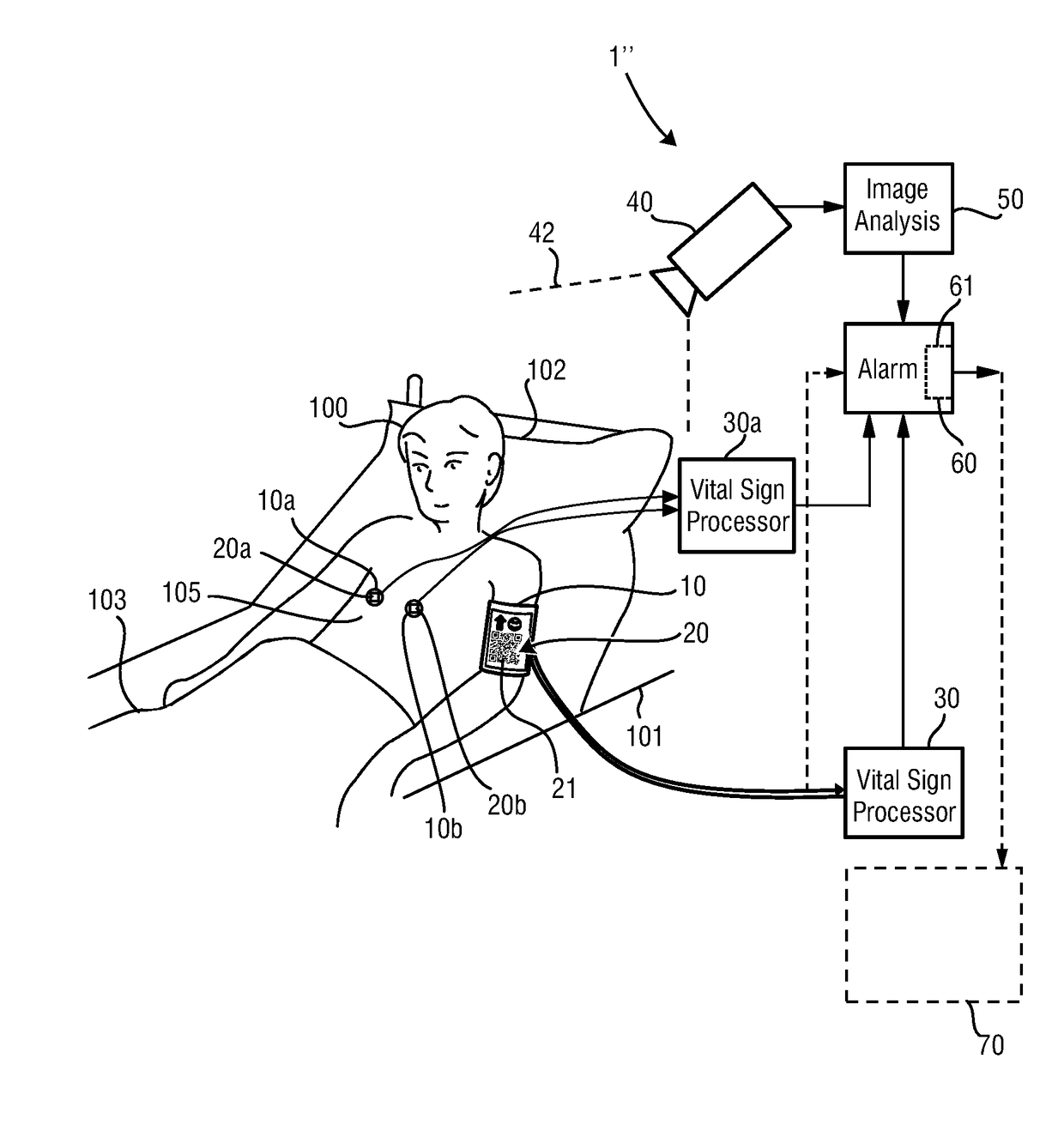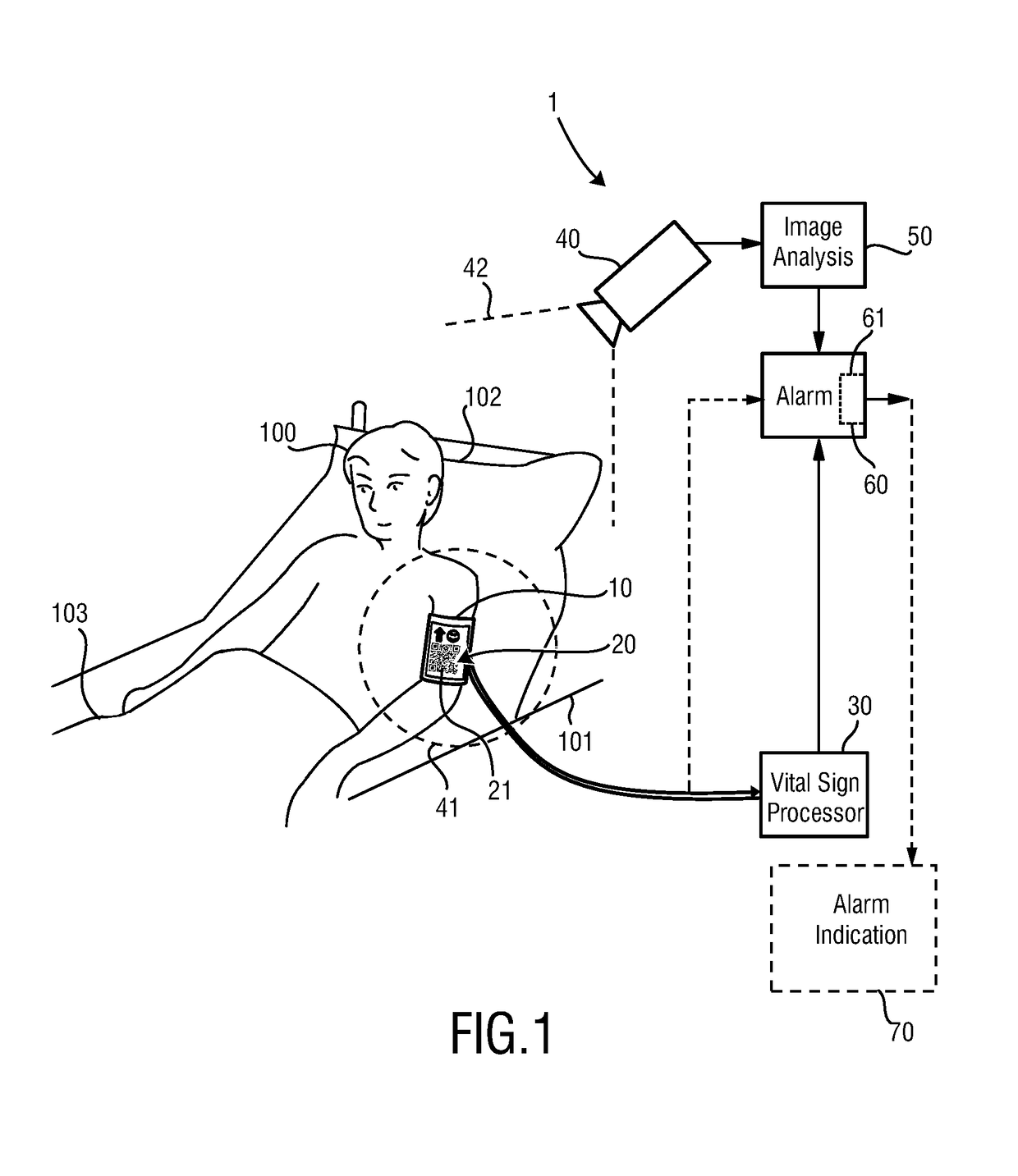System and method for determining a vital sign of a subject
a vital sign and system technology, applied in the field of patient monitoring systems and methods, can solve problems such as unresolved problems, alarm noise levels around 80 db, and caregivers' desensitization against alarms, and achieve the effect of reliably reducing the probability of false alarms and significantly reducing the probability
- Summary
- Abstract
- Description
- Claims
- Application Information
AI Technical Summary
Benefits of technology
Problems solved by technology
Method used
Image
Examples
first embodiment
[0049]FIG. 1 schematically shows a system 1 for determining a vital sign of a subject 100. The subject 100, in this example a patient, lies in a bed 101, wherein the head of the subject 100 is located on a pillow 102 and the subject 100 is covered with a blanket 103. A sensor 10 is fixed to the subject 100 for measuring a vital sign information signal of said subject. Here, the sensor 10 is a blood pressure cuff arranged on the subject's upper are for measuring the blood pressure of the subject 100.
[0050]A marker 20 is attached to the sensor 10, e.g. printed on the outer surface of the blood pressure cuff or attached there in the form of a sticker. In this embodiment the marker 20 is a passive marker comprising a graphical pattern 21, here a so-called QR-code. The QR-code may feature different structural elements allowing for a machine-readable determination of the orientation and / or location of the graphical pattern 21. The marker 20 may be visible or invisible to the human eye, e....
second embodiment
[0063]FIG. 2 schematically shows a system 1′ for determining a vital sign of a subject 100. In this embodiment a pulse oximeter in the form of a fingerclip is used as sensor 10′, which is arranged at a patient's finger 104 for continuously measuring the oxygen saturation (SpO2) as vital sign. Such pulse oximeters are generally known in the art and shall not be described herein in more detail.
[0064]In or on the sensor 10′ an active marker 20′ is arranged, here in form of a light source, e.g. an LED emitting visible or infrared light. Within the image data the imaging unit 40 can detect the active marker 20′ and can detect movements of the active marker 20′ (and, thus, of the sensor 10′) over time. The other elements of the system basically correspond to the corresponding elements of the system 1 shown in FIG. 1.
[0065]The marker 20′ can be thought of as a light beacon, which emits light into the environment. The intensity of the light can be time varying, i.e., coded light can be emit...
third embodiment
[0078]FIG. 3 schematically shows a system 1″ for determining a vital sign of a subject 100. In this embodiment the system 1″ comprises, in addition to the elements of the system 1 shown in FIG. 1, additional sensors 10a, 10b which are ECG electrodes attached to the chest 105 of the subject 100 for measuring an ECG signal. The electrode signals are provided to an additional vital sign processor 30a (or, alternatively, to the vital sign processor 30) where the electrode signals are evaluated to obtain the ECG signal as additional vital sign which is also provided to the alarm unit 60.
[0079]Each of said additional sensors 10a, 10b is provided with a respective marker 20a, 20b, which may be active or passive markers as described above. The markers 21a, 21b are also monitored by the imaging unit 40 to detect their motion and, thus, motion of the sensors 10a, 10b. Thus, for each individual sensor 10, 10a, 10b it can be judged how reliable the signal measured by the respective sensor is. F...
PUM
 Login to View More
Login to View More Abstract
Description
Claims
Application Information
 Login to View More
Login to View More - R&D
- Intellectual Property
- Life Sciences
- Materials
- Tech Scout
- Unparalleled Data Quality
- Higher Quality Content
- 60% Fewer Hallucinations
Browse by: Latest US Patents, China's latest patents, Technical Efficacy Thesaurus, Application Domain, Technology Topic, Popular Technical Reports.
© 2025 PatSnap. All rights reserved.Legal|Privacy policy|Modern Slavery Act Transparency Statement|Sitemap|About US| Contact US: help@patsnap.com



